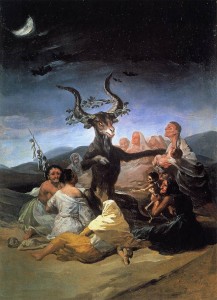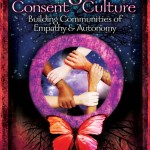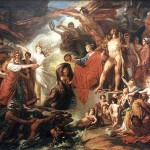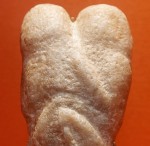Over at Common Tansy, Pat Mosley has been tearing it up with his posts about the Devil in witchcraft, A Case for Inviting Satan (Back) to Wicca and Prying Open the Devil’s Broom Closet. And Ian Corrigan has also written on the topic of the Devil and the darker side of Paganism. Jason Mankey has written about the origins of the Horned God of Wicca.

The Devil and witchcraft
Some folkloric Craft practitioners have always honoured both Lucifer and Jesus, regarding them as brothers (from the reference in the Book of Job about Samael being among the Sons of God). Cain is also an important figure in their mysteries, and is viewed as the son of Samael and Lilith. And Tubal-Cain is viewed as the earthly vessel of Azazel. They place a lot of importance on the smith-gods such as Prometheus, Tubal-Cain, Hephaestos, Wayland, and Vulcan.
I can understand why some Wiccans completely denied that they even believed in the Devil, as I vividly remember the fear instilled in us by the Satanic Panic of the late 1980s. It is much easier to say “we don’t believe in your mythology at all” than it is to say something more complicated, such as “we don’t accept your dualistic cosmology, but we do believe there is a place for acknowledging the darker aspects of the psyche, and deities associated with them, and rather than demonising them, it would be better to integrate those forces into consciousness and work with their energies”. Some Wiccan and Pagan writers actually did attempt to convey this more complicated message.
Various concepts and images of these entities are lurking about in the basement of the Western psyche – but we are not powerless to change them. Some people will prefer to ignore them altogether; others feel the need to change these images by working with them. That is their prerogative.
However, there is no need to throw Satanists under the bus when stating that Wiccans don’t worship the Devil. There are at least three different flavours of Satanism, the philosophical and anarchist variety allegedly espoused by Mikhail Bakunin, the inversion-of-Christianity variety, and the people who are actually worshipping the Egyptian god Set. Therefore, claiming that Satanism is “just an inversion of Christianity” is an inadequate explanation of what it actually is.
I have not met that many Satanists, and many of the ones I have met have taken considerable pleasure in being self-consciously “dark” and very left-hand-path. Some of the ones I have met were very right-wing. There are nasty people in every group, but that doesn’t mean that all of them are like that. I also know a couple of Setians and some left-wing Satanists.
It is worth pointing out that an acknowledgement of the possible existence of Lucifer, or Samael, or any other such entity, does not mean that we are suddenly Satanists. Some Wiccans have been acknowledging Lilith for years – so why is Samael so taboo?
I think that Wicca and Satanism are two separate and distinct traditions, but we are not being fair and reasonable if we demonise Satanism in the same way that some Christians have done to us.
Who cleft the Devil’s foot?
From a hard(ish) polytheist point of view, I would argue that Lucifer, Satan, Samael, Asmodeus, Beelzebub, and various other entities are different beings. They may have got lumped together as one by the monotheists, but then I think we would all agree that monotheists have a tin ear when it comes to mythology. One of the Pagan deities whose image fed into the Christian concept of the Devil was Pan, and it is thought that that is how the Devil acquired his cloven hooves (unless it was from the image of Azazel as the scapegoat).
Some people have argued that neither Jesus nor Satan have a place in contemporary Paganisms, because we don’t accept the dualistic and antagonistic world-view of Christianity. However, I don’t have to accept that monotheism’s assessment of the stature or nature of a being is true in order to accept that the being (or at least, its archetype) exists. I don’t accept the philosophy of Buddhism, but I am happy to honour Kwan-Yin. I think Jesus probably exists, but I certainly don’t accept monotheism’s view of who he is. So why not his brother Lucifer? We don’t accept Christianity’s assessment that all our deities are the devil in disguise – so why should we accept their view of Lucifer?
Northern Light 27 points out that the various deities that were some form of adversary (and a necessary source of creative conflict) in the pre-Christian pagan religions all got lumped together to form the Christian version of the devil as the main adversary of Yahweh. What’s more, the Jewish concept of Samael / Satan was quite different, and existed alongside other figures such as Lilith as necessary aspects of the cosmic order.
I think the Christian view was probably influenced either by the two gods of Zoroastrianism (Ahura Mazda and Angra Mainyu), or by the good and evil entities of Manichaeism. Manichaeism was essentially a Gnostic view of the world that held that matter was created by an evil demiurge, and that the source of all good was the creator, to whom light and spirit seek to return by escaping from matter. Zoroastrians, on the other hand, say that the world was created by Ahura Mazda, the good god. However, both systems have an ultimate force of good pitted against an ultimate force of evil. Contrast this with Judaism, where Samael was essentially under the control of Yahweh – in this view, Samael existed to punish transgressors. If you look at the history of Jewish mythologization of Satan, Samael, Azazel, Asmodeus, and other characters, it is pretty clear that they are much more nuanced than the Christian versions. I really wish people would not conflate Judaism and Christianity, or back-project Christian attitudes onto Judaism, which is a completely different religion that Christianity is a massive distortion of. (And as far as I know, it is a heresy in Christianity to regard the Devil as being of equal power with God.)
As I do not accept monotheism’s view that there is only one god and one adversary, I have room in my concept of deities for some that like to promote conflict for whatever reason they think it necessary (even if they don’t happen to be among the deities with whom I have a personal relationship, because I do not like conflict). If I acknowledge the existence of Lilith and Loki and Set and Yahweh and Asherah, then I am prepared to accept that Lucifer, Samael, and Asmodeus also exist. And Baphomet too.
My polytheism consists of acknowledging the existence of many deities, and honouring and/or worshipping those that have called to me. So far, only one of these entities has come knocking at my door, but if one of the others shows up, I think I would make my own assessment of their character. After all, Christianity was very rude about all our other deities – why should I take their word for it about any entity?
As to whether the Wiccan Horned God contains a bit of the Devil in his DNA… I think he probably does. If the Devil is equated in the Christian world-view with prancing about naked by moonlight, joyous love-making, and wild shenanigans – then the God of the Witches does represent these things.
What is interesting is that Pan, who may have informed some of the Christian idea of the Devil (because he represents wildness and wilderness and unbridled sexuality) is one of the few beings involved that was not an adversary figure in ancient mythology. (Though the Devil’s horns and hooves may have come from Azazel the scapegoat rather than from Pan.)
In Charles Godfrey Leland’s Aradia: the gospel of the witches, Aradia is presented as the consort of Lucifer, and it appears that Gerald Gardner and Doreen Valiente replaced Lucifer with Cernunnos when they were forming Wicca – in part because they believed Margaret Murray’s theory that the being worshipped by witches was an ancient pagan Horned God (but also because they were well aware of the media furore that would result if they admitted to devil-worship). However, it appears from some research by Sabina Magliocco that the legend of Aradia actually pre-dates the association of witchcraft with devil-worship.
Horned deities in India were possibly associated with shamanism and animism, both of which have been viewed as transgressive by established religions.
It is also worth noting that the word demon (daimon in Greek) originally meant a spirit of place, or the genius of a gifted person, and had no negative connotation in ancient paganism.
My personal theology celebrates the marriage of spirit and matter, and not their separation. I celebrate wildness, and chaos, and the celebration of physical pleasure. I do not think that blind obedience is a virtue. So I think a deity that represents anarchy, and rebellion against absolute authority, is worth looking into.
Adversaries in ancient paganisms
Some ancient paganisms had the concept of a struggle between two groups of deities (in Greek mythology, the clash of the Olympian gods with their rivals, the Titans; and in Norse mythology, the clash of the Aesir and Vanir with the giants) but these were not so much conceived of as a struggle of good and evil, as a struggle between natural forces such as fire and ice, some of which were more inimical to humans than others. But things were complicated in the Greek myths because Prometheus stole fire from the gods to give to humanity (an impious act, but one for which we can be grateful). And in the Norse myths, the gods were born from the primal giant, Ymir, and then slew him to make the heavens and the Earth.
Some ancient religions of the Near East had powerful beings who were slain by the creator god (for example in Sumerian mythology, Tiamat the serpent goddess was slain by Marduk, who formed the Earth from her body – probably the original of many dragon-slayer stories). We can trace some of the motifs that went into the making of the archetype of the Devil back to some of these figures.
Be careful
I’ve got to admit that the name ‘Satan’ makes me really uncomfortable. I am much more comfortable with ‘Old Nick’, ‘Lucifer’, or even ‘the Devil’. But then I am curious to delve into the depths and find out why it makes me uncomfortable.
However, given the enormous weight of negativity attached to the archetype of the Devil, anyone invoking these entities needs to be really careful to invoke the aspects of the complex that they want (the freedom, anarchy, hedonism, and sex-positive aspects) and avoid the negative associations with it (selfishness, greed, destructive impulses, etc). I find it very interesting that most people work with lesser-known names and beings such as Samael and Lucifer (arguably the bright side of this archetype) and avoid the more negative aspects. So much negativity has been loaded onto the archetype that it may be really difficult to recover the bright aspects of it. If you do invoke or evoke such a being, are you a powerful enough magician to handle it?
Civilisation and its discontents
It is fairly easy to see how gods of the wildwood (symbols of the wilderness and therefore opposed to civilisation, with which Christianity strongly identifies itself) may have fed into the Christian archetype of the Devil. Recently, I read Lolly Willowes, or the Loving Huntsman by Sylvia Townsend Warner, and in that book (written in 1926), the god of the witches is unequivocally represented (with considerable glee) as Satan. He is quite kindly, and the freedom of the countryside where he holds sway is contrasted with the stifling atmosphere of middle-class respectability from which the heroine escapes.
Many myths and legends (from ancient times until very recently) are about the struggle to establish civilisation and order, set against the urge to return to a state of nature and chaos. It has not been universally agreed that the imposition of law and order and civilisation is necessarily all good.
If someone was to draw a mindmap or a family tree describing all these entities and their mythological relationship with each other, it would get quite complicated. The massive number of references to the Devil in popular culture add an extra layer of complexity.
So – when you say that you don’t worship the Devil, you might need to be a bit more specific. Do you mean Old Nick, Satan, Asmodeus, Azazel, Beelzebub, Baphomet, Samael, Lucifer, Mephistopheles, Angra Mainyu, Iblis, Loki, Set, Apep, Prometheus, or some other adversarial figure? The Devil really is in the details.












